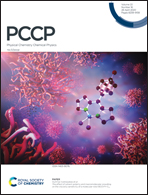Study of the GaAs/SiH van der Waals type-II heterostructure: a high efficiency photocatalyst promoted by a built-in electric field
Abstract
The application of two-dimensional (2D) materials to construct van der Waals (vdW) heterostructures in photocatalysis has attracted extensive attention recently. However, exploration of ways to enhance the photocatalytic efficiency at the interface is relatively limited. In this study, using density functional theory, we prove that GaAs/SiH formed a standard type-II heterojunction with a 2.17 eV direct band gap. The charge transfer across the interface was investigated by the charge density difference and Bader charge analysis. Due to the difference in the work functions, the relative positions of the conduction band (CB) and valence band (VB) of GaAs and SiH present a significant change after the heterostructure is formed. Furthermore, the built-in electric field, formed by charge transfer at the interface of the GaAs/SiH heterojunction, promotes photogenerated carrier separation. The band edge position and the absorption spectrum were calculated and the photocatalytic performance of the GaAs/SiH vdW heterostructure in the visible light region was evaluated. Strong absorption is observed, which predicts promising application in photonic detection across the visible and the UV region. Excitingly, GaAs/SiH has a significant advantage for improving the photocatalytic efficiency under visible light irradiation. Our work can provide guidance for the design of other highly efficiency heterostructures.



 Please wait while we load your content...
Please wait while we load your content...